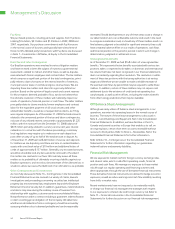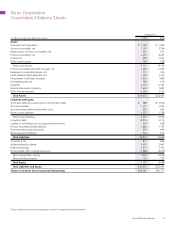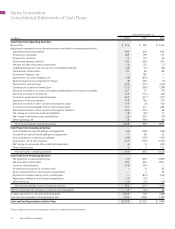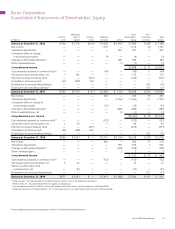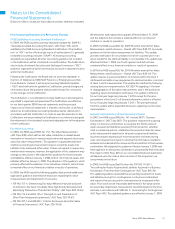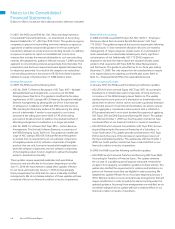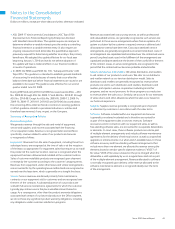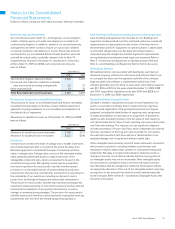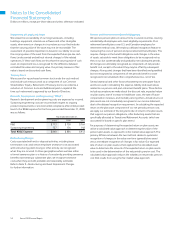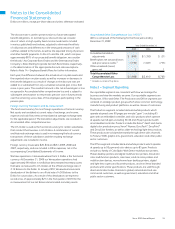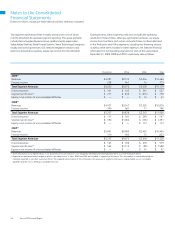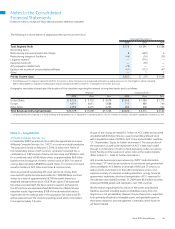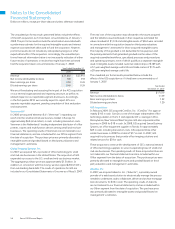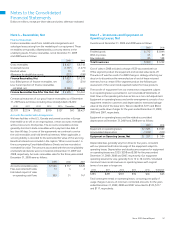Xerox 2009 Annual Report Download - page 51
Download and view the complete annual report
Please find page 51 of the 2009 Xerox annual report below. You can navigate through the pages in the report by either clicking on the pages listed below, or by using the keyword search tool below to find specific information within the annual report.
49Xerox 2009 Annual Report
Notes to the Consolidated
Financial Statements
Dollars in millions, except per-share data and unless otherwise indicated.
Revenues associated with outsourcing services, as well as professional
and value-added services, are generally recognized as such services are
performed. In those service arrangements where final acceptance of a
system or solution by the customer is required, revenue is deferred until
all acceptance criteria have been met. Costs associated with service
arrangements are generally recognized as incurred. Initial direct costs of
an arrangement are capitalized and amortized over the contractual service
period. Long-lived assets used in the fulfillment of the arrangements are
capitalized and depreciated over the shorter of their useful life or the term
of the contract. Losses on service arrangements are recognized in the
period that the contractual loss becomes probable and estimable.
Sales to distributors and resellers: We utilize distributors and resellers
to sell certain of our products to end users. We refer to our distributor
and reseller network as our two-tier distribution model. Sales to
distributors and resellers are generally recognized as revenue when
products are sold to such distributors and resellers. Distributors and
resellers participate in various cooperative marketing and other
programs, and we record provisions for these programs as a reduction
to revenue when the sales occur. Similarly, we account for our estimates
of sales returns and other allowances when the sales occur based on
our historical experience.
Supplies: Supplies revenue generally is recognized upon shipment
or utilization by customers in accordance with the sales terms.
Software: Software included within our equipment and services
is generally considered incidental and is therefore accounted for
as part of the equipment sales or services revenues. Software
accessories sold in connection with our equipment sales, as well as
free-standing software sales, are accounted for as separate deliverables
or elements. In most cases, these software products are sold as part
of multiple-element arrangements and include software maintenance
agreements for the delivery of technical service, as well as unspecified
upgrades or enhancements on a when-and-if-available basis. In those
software accessory and free-standing software arrangements that
include more than one element, we allocate the revenue among the
elements based on vendor-specific objective evidence (“VSOE”) of
fair value. VSOE of fair value is based on the price charged when the
deliverable is sold separately by us on a regular basis and not as part
of the multiple-element arrangement. Revenue allocated to software
is normally recognized upon delivery, while revenue allocated to the
software maintenance element is recognized ratably over the term
of the arrangement.
•ASU 2009-17 which amends Consolidations (ASC Topic 810):
Improvements to Financial Reporting by Enterprises Involved
with Variable Interest Entities. This update requires an analysis to
determine whether a variable interest gives the entity a controlling
financial interest in a variable interest entity. It also requires an
ongoing reassessment and eliminates the quantitative approach
previously required for determining whether an entity is the primary
beneficiary. We adopted this update effective for our fiscal year
beginning January 1, 2010 and we do not believe adoption of
this update will have a material effect on our financial condition
or results of operations.
•In 2009, the FASB issued SFAS No. 165, “Subsequent Events” (ASC
Topic 855). This guidance is intended to establish general standards
of accounting for and disclosures of events that occur after the
balance sheet date but before financial statements are issued or are
available to be issued. This guidance was effective for our second
quarter ended June 30, 2009.
During 2009 and early 2010, the FASB has issued several ASUs – ASU
No. 2009-02 through ASU No. 2009-17 and ASU No. 2010-01 through
ASU No. 2010-08. Except for ASUs No. 2009-05, 2009-13, 2009-14,
2009-16, 2009-17, 2010-01, 2010-02 and 2010-06 discussed above,
the remaining ASUs entail technical corrections to existing guidance
or affect guidance related to specialized industries or entities and
therefore have minimal, if any, impact on the Company.
Summary of Accounting Policies
Revenue Recognition
We generate revenue through the sale and rental of equipment,
service and supplies, and income associated with the financing
of our equipment sales. Revenue is recognized when earned. More
specifically, revenue related to sales of our products and services
is recognized as follows:
Equipment: Revenues from the sale of equipment, including those from
sales-type leases, are recognized at the time of sale or at the inception
of the lease, as appropriate. For equipment sales that require us to install
the product at the customer location, revenue is recognized when the
equipment has been delivered and installed at the customer location.
Sales of customer installable products are recognized upon shipment
or receipt by the customer according to the customer’s shipping terms.
Revenues from equipment under other leases and similar arrangements
are accounted for by the operating lease method and are recognized as
earned over the lease term, which is generally on a straight-line basis.
Service: Service revenues are derived primarily from maintenance
contracts on our equipment sold to customers and are recognized over
the term of the contracts. A substantial portion of our products are
sold with full-service maintenance agreements for which the customer
typically pays a base service fee plus a variable amount based on
usage. As a consequence, other than the product warranty obligations
associated with certain of our low end products in the Office segment,
we do not have any significant product warranty obligations, including
any obligations under customer satisfaction programs.



